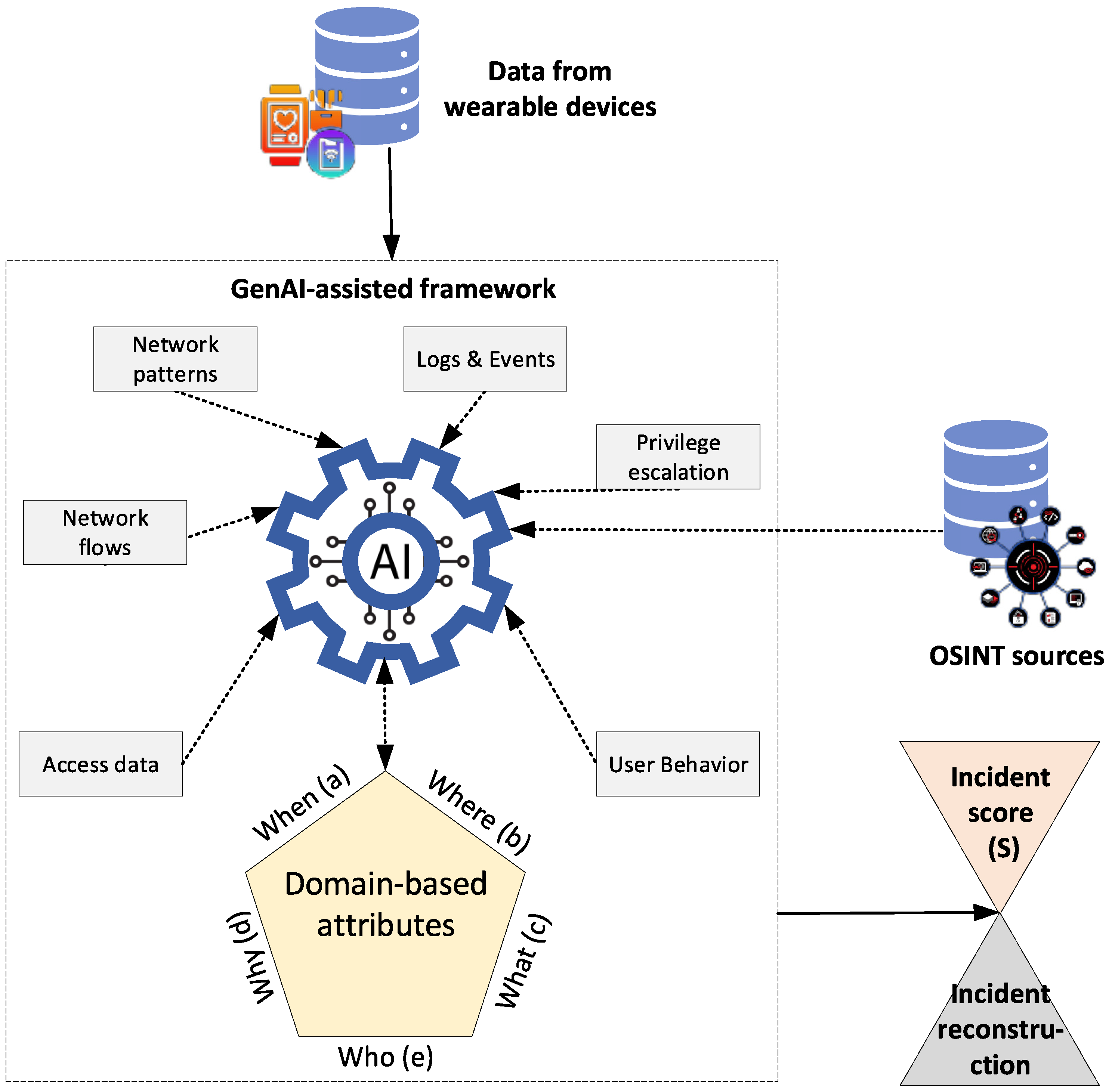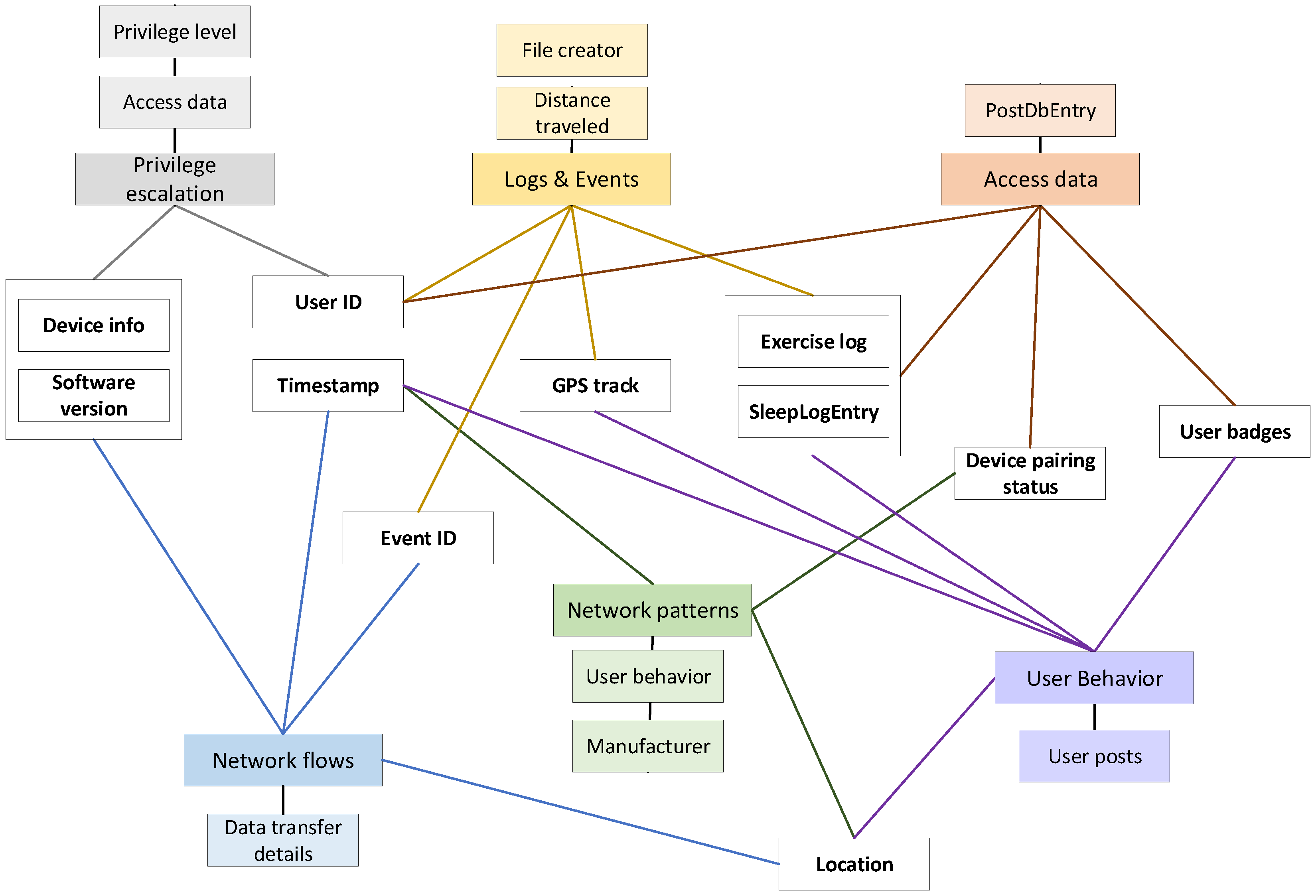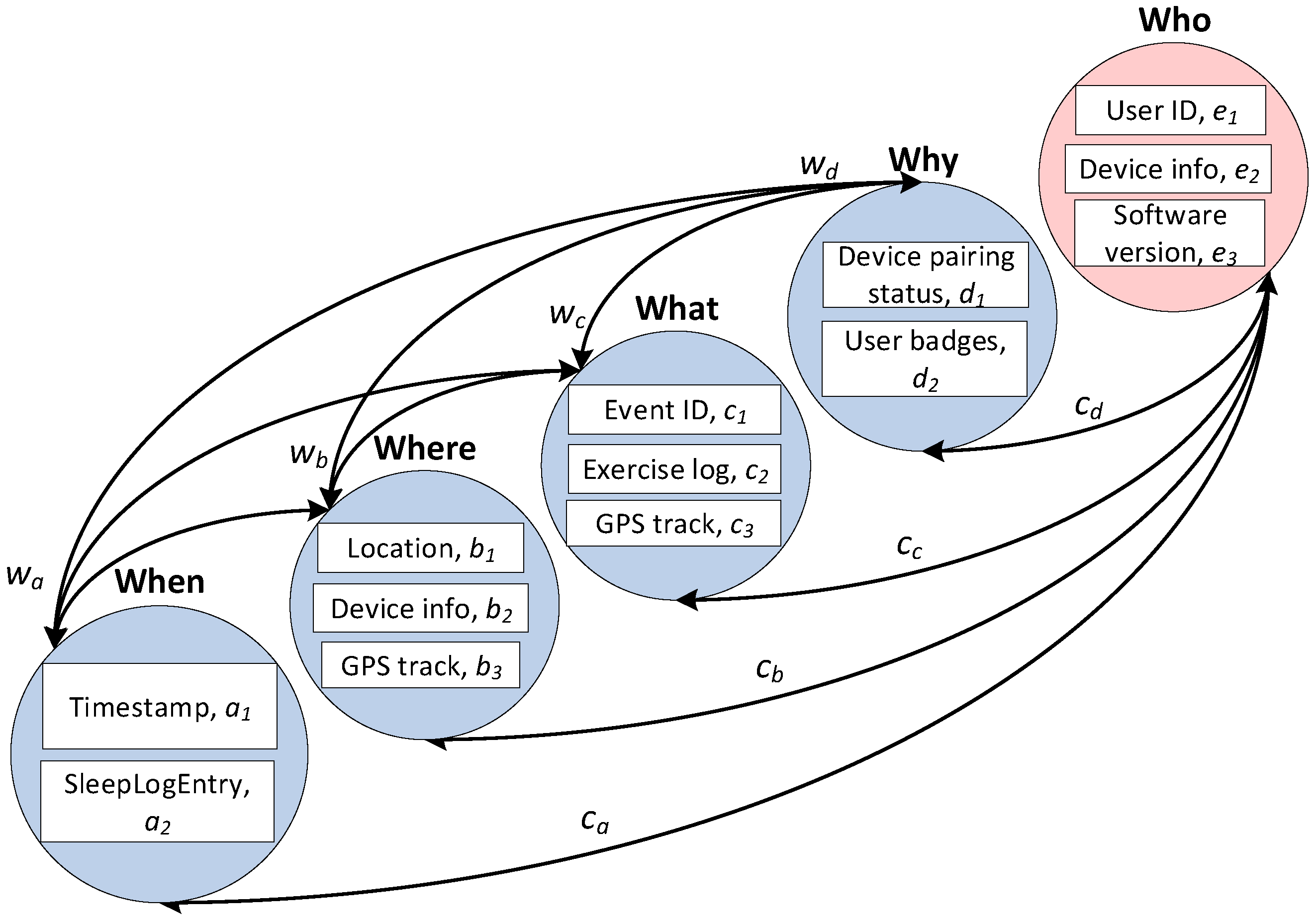Navigating the CISO’s Mind by Integrating GenAI for Strategic Cyber Resilience
Abstract
1. Introduction
- RQ1: How can a GenAI-assisted framework be developed to enhance the accuracy and comprehensiveness of cyberforensics in wearable devices by effectively integrating and cross-layering digital evidence between the network and application domains?
- RQ2: How can this framework, through the integration of OSINT, identify and reconstruct a malicious incident while providing a holistic view of the incident under the 5W umbrella?
- How to develop an GenAI-assisted methodology for cross-layered evidence synthesis in cyberforensics;
- How to design an OSINT integration process for wearable device data analysis, thus creating a more complete understanding of malicious incidents involving wearable devices;
- How to validate the GenAI-assisted framework using real-world case studies or datasets to demonstrate identification of malicious activities and the behavioral profiling of potential attackers;
- How to address the current limitations in cyberforensics by bridging the gap between different forensic layers and integrating AI-driven insights, ultimately supporting CISOs in improving cyber resilience and preparedness.
2. Related Research
3. GenAI-Assisted Framework for Cyberforensics
3.1. Framework Architecture and Components
3.2. The 5W Approach for Attribute Analysis and Scoring
4. Experimental Use Case
4.1. Extraction of Attributes from Wearable Devices and OSINT Data
4.2. Experimental Validation with Public Datasets
- Wearable device: Garmin Vivoactive 4 (Bluetooth address: 14:13:0B:01:92);
- Master device: Samsung Galaxy S20 FE (Bluetooth address: 34:82:C5:37:DC:48).
- Recording device model: USRP X310 (software-defined radio); Daughterboard CBX-120; UHD Version 4.1.0.5-3;
- Wearable device model: Garmin Vivoactive 4; Bluetooth version 5.0; Android app Connect (version: 4.70);
- Master device model: Samsung Galaxy S20 FE; Bluetooth version 5.0.
- Recording duration: 16.986 s;
- Timeline description: enabling Bluetooth on smartphone = 1.307 s; disconnected duration = 14.98 s.
- Bluetooth communication: Bluetooth version 5.0 was used between the smartwatch and the smartphone.
- Recording date: 21 November 2023;
- Recording location: EDI.
- The Garmin Vivoactive 4 recorded the user’s location in Edinburgh, Scotland, specifically in the city center area, near Princes Street. Princes Street is a well-known street in the city, often frequented by residents and tourists. (Remarks: This location information may be useful for corroborating user activity within Edinburgh’s city center, especially in identifying any deviations from typical routes or verifying known events during the given timestamp).
- The Samsung Galaxy S20 FE, which serves as the master device, recorded GPS data which placed the user in Edinburgh, Scotland, specifically near Queen Street. Queen Street is within the central business district, which implies that the user was in a commercial area. (Remarks: These GPS data are significant as they tie the user’s presence to a location in the commercial hub, which could have implications for activity verification, business interactions or identifying potential exposure to specific threats).
- The GPS data from the Google Pixel Watch indicated the user’s presence near Holyrood Park, located in Edinburgh, Scotland. The data points specifically pointed to the Holyrood Road area, which is popular for outdoor activities and recreational use. (Remarks: This information is crucial for verifying user fitness activities, analyzing movement patterns and identifying any unusual activities that may not align with the user’s regular behavior).
5. Discussion and Limitations
5.1. Infrastructure and Performance Limitations
5.2. Data Accuracy and Operational Concerns
5.3. Practical Implementation
6. Conclusions and Future Work
Author Contributions
Funding
Institutional Review Board Statement
Informed Consent Statement
Data Availability Statement
Conflicts of Interest
References
- Ministry of National Defence. National Cyber Security Status Report. 2023. Available online: https://www.nksc.lt/doc/Nacionaline-kibernetinio-saugumo-ataskaita-2023.pdf (accessed on 28 December 2024).
- ENISA. The European Union Agency for Cybersecurity. Artificial Intelligence and Cybersecurity Research. 2023. Available online: https://www.enisa.europa.eu/sites/default/files/publications/Artificial%20Intelligence%20and%20Cybersecurity%20Research.pdf (accessed on 8 January 2025).
- European Union. Commission Welcomes Political Agreement on Artificial Intelligence Act. 2023. Available online: https://ec.europa.eu/commission/presscorner/detail/en/ip_23_6473 (accessed on 18 January 2025).
- Kalodanis, K.; Rizomiliotis, P.; Anagnostopoulos, D. European Artificial Intelligence Act: An AI security approach. Inf. Comput. Secur. 2024, 32, 265–281. [Google Scholar]
- Jemmett, D. CISO Workforce and Headcount 2023 Report. 2023. Available online: https://www.ciso.inc/2023-ciso-report/ (accessed on 18 January 2025).
- Huang, K.; Ponnapalli, J.; Tantsura, J.; Shin, K.T. Navigating the GenAI Security Landscape. In Generative AI Security: Theories and Practices; Springer: Berlin/Heidelberg, Germany, 2024; pp. 31–58. [Google Scholar]
- Prasad, S.G.; Sharmila, V.C.; Badrinarayanan, M. Role of artificial intelligence based chat generative pre-trained transformer (chatgpt) in cyber security. In Proceedings of the 2023 2nd International Conference on Applied Artificial Intelligence and Computing (ICAAIC), Salem, India, 4–6 May 2023; IEEE: Piscataway, NJ, USA, 2023; pp. 107–114. [Google Scholar]
- Mitra, R.; Schwieger, D.; Roy, I. Educating the Next Generation of CSOs: An Exercise in Conversational Role Play with ChatGPT. In Proceedings of the ISCAP Conference ISSN, Albuquerque, NM, USA, 1–4 November 2023; Volume 2473, p. 4901. [Google Scholar]
- Dhoni, P. Unleashing the potential: Overcoming hurdles and embracing generative AI in IT workplaces: Advantages, guidelines, and policies. TechRxiv 2023. [Google Scholar] [CrossRef]
- Yigit, Y.; Buchanan, W.; Tehrani, M.; Maglaras, L. Review of Generative AI Methods in Cybersecurity. arXiv 2024, arXiv:2403.08701. [Google Scholar]
- ISC2. ISC2 Spotlight: Modernizing Security Operations. 2023. Available online: https://www.isc2.org/Insights/2023/10/ISC2-Spotlight-Modernizing-Security-Operations (accessed on 18 January 2025).
- MacDermott, A.; Lea, S.; Iqbal, F.; Idowu, I.; Shah, B. Forensic analysis of wearable devices: Fitbit, Garmin and HETP Watches. In Proceedings of the 2019 10th IFIP International Conference on New Technologies, Mobility and Security (NTMS), Canary Islands, Spain, 24–26 June 2019; IEEE: Piscataway, NJ, USA, 2019; pp. 1–6. [Google Scholar]
- Zhang, Z.; Al Hamadi, H.; Damiani, E.; Yeun, C.Y.; Taher, F. Explainable artificial intelligence applications in cyber security: State-of-the-art in research. IEEE Access 2022, 10, 93104–93139. [Google Scholar] [CrossRef]
- Henriques, J.; Caldeira, F.; Cruz, T.; Simões, P. A survey on forensics and compliance auditing for critical infrastructure protection. IEEE Access 2024, 12, 2409–2444. [Google Scholar] [CrossRef]
- Ministry of National Defence. National Cyber Security Strategy. 2022. Available online: https://kam.lt/wp-content/uploads/2022/03/nacionaline-kibernetinio-saugumo-strategija.pdf (accessed on 11 January 2025).
- Iturbe, E.; Rios, E.; Rego, A.; Toledo, N. Artificial Intelligence for next generation cybersecurity: The AI4CYBER framework. In Proceedings of the 18th International Conference on Availability, Reliability and Security, Benevento, Italy, 29 August–1 September 2023; pp. 1–8. [Google Scholar]
- Preuveneers, D.; Joosen, W. An Ontology-Based Cybersecurity Framework for AI-Enabled Systems and Applications. Future Internet 2024, 16, 69. [Google Scholar] [CrossRef]
- Bagirovs, E.; Provodin, G.; Sipola, T.; Hautamäki, J. Applications of Post-quantum Cryptography. arXiv 2024, arXiv:2406.13258. [Google Scholar] [CrossRef]
- Bountakas, P.; Fysarakis, K.; Kyriakakis, T.; Karafotis, P.; Aristeidis, S.; Tasouli, M.; Alcaraz, C.; Alexandris, G.; Andronikou, V.; Koutsouri, T.; et al. SYNAPSE—An Integrated Cyber Security Risk & Resilience Management Platform, with Holistic Situational Awareness, Incident Response & Preparedness Capabilities: SYNAPSE. In Proceedings of the 19th International Conference on Availability, Reliability and Security, Vienna, Austria, 30 July–2 August 2024; pp. 1–10. [Google Scholar]
- European Union. A European Cyber Resilience Framework with Artificial Intelligence-Assisted Orchestration & Automation for Business Continuity, Incident Response & Information Exchange. 2022. Available online: https://cordis.europa.eu/project/id/101070586 (accessed on 11 January 2025).
- Rastogi, N.; Dhanuka, D.; Saxena, A.; Mairal, P.; Nguyen, L. Survey Perspective: The Role of Explainable AI in Threat Intelligence. arXiv 2025, arXiv:2503.02065. [Google Scholar]
- Abusitta, A.; Li, M.Q.; Fung, B.C. Survey on Explainable AI: Techniques, challenges and open issues. Expert Syst. Appl. 2024, 255, 124710. [Google Scholar]
- Capuano, N.; Fenza, G.; Loia, V.; Stanzione, C. Explainable artificial intelligence in cybersecurity: A survey. IEEE Access 2022, 10, 93575–93600. [Google Scholar]
- Qureshi, S.U.; He, J.; Tunio, S.; Zhu, N.; Nazir, A.; Wajahat, A.; Ullah, F.; Wadud, A. Systematic review of deep learning solutions for malware detection and forensic analysis in IoT. J. King Saud Univ.-Comput. Inf. Sci. 2024, 36, 102164. [Google Scholar]
- Ahmed, A.A.; Farhan, K.; Jabbar, W.A.; Al-Othmani, A.; Abdulrahman, A.G. IoT forensics: Current perspectives and future directions. Sensors 2024, 24, 5210. [Google Scholar] [CrossRef] [PubMed]
- Rodrigues, F.B.; Giozza, W.F.; de Oliveira Albuquerque, R.; Villalba, L.J.G. Natural language processing applied to forensics information extraction with transformers and graph visualization. IEEE Trans. Comput. Soc. Syst. 2022, 11, 4727–4743. [Google Scholar] [CrossRef]
- Odom, N.R.; Lindmar, J.M.; Hirt, J.; Brunty, J. Forensic inspection of sensitive user data and artifacts from smartwatch wearable devices. J. Forensic Sci. 2019, 64, 1673–1686. [Google Scholar]
- Yoon, Y.H.; Karabiyik, U. Forensic analysis of fitbit versa 2 data on android. Electronics 2020, 9, 1431. [Google Scholar] [CrossRef]
- Mishra, P. Secured Novel Lightweight IoT End Device Architecture using Confidentiality, Integrity, Authenticity & Availability based tight security approach. Turk. J. Comput. Math. Educ. (TURCOMAT) 2021, 12, 6768–6778. [Google Scholar]
- Zhou, H. Comparison of Encryption Algorithms for Wearable Devices in IoT Systems. Eng. Adv. 2023, 3, 144–148. [Google Scholar]
- Baucas, M.J.; Spachos, P.; Plataniotis, K.N. Federated learning and blockchain-enabled fog-IoT platform for wearables in predictive healthcare. IEEE Trans. Comput. Soc. Syst. 2023, 10, 1732–1741. [Google Scholar]
- Santosa, G.B.; Budiyanto, S. New design of lightweight authentication protocol in wearable technology. TELKOMNIKA (Telecommun. Comput. Electron. Control) 2019, 17, 561–572. [Google Scholar]
- Yu, S.; Park, Y. Robust and Efficient Authentication and Group–Proof Scheme Using Physical Unclonable Functions for Wearable Computing. Sensors 2023, 23, 5747. [Google Scholar] [CrossRef]
- NIST; Aroms, E. NIST Special Publication 800-86 Guide to Integrating Forensic Techniques into Incident Response; NIST: Gaithersburg, MD, USA, 2012.
- EDI Riga. Wearable_Device_Dataset. 2024. Available online: https://github.com/edi-riga/Wearable_device_dataset (accessed on 11 January 2025).
- BBC. Man Admits Planting ‘Bomb’ in Edinburgh’s Princes Street Gardens. 2022. Available online: https://www.bbc.com/news/uk-scotland-edinburgh-east-fife-60059070 (accessed on 19 January 2025).
- BBC. Barclays Branches Across UK Targeted by Protesters. 2024. Available online: https://www.bbc.com/news/articles/c1rrzp1qwp1o (accessed on 19 January 2025).
- Chrysostomou, G.; Zhao, Z.; Williams, M.; Aletras, N. Investigating hallucinations in pruned large language models for abstractive summarization. Trans. Assoc. Comput. Linguist. 2024, 12, 1163–1181. [Google Scholar]
- Ji, Z.; Lee, N.; Frieske, R.; Yu, T.; Su, D.; Xu, Y.; Ishii, E.; Bang, Y.J.; Madotto, A.; Fung, P. Survey of hallucination in natural language generation. ACM Comput. Surv. 2023, 55, 1–38. [Google Scholar]
- Farquhar, S.; Kossen, J.; Kuhn, L.; Gal, Y. Detecting hallucinations in large language models using semantic entropy. Nature 2024, 630, 625–630. [Google Scholar] [PubMed]
- Grossman, M.R.; Grimm, P.W.; Brown, D.G. Is disclosure and certification of the use of generative AI really necessary? Judicature 2023, 107, 68–77. [Google Scholar]
- Yamin, M.M.; Hashmi, E.; Ullah, M.; Katt, B. Applications of llms for generating cyber security exercise scenarios. Preprint 2024, 12, 143806–143822. [Google Scholar]
- Patil, R.; Heston, T.F.; Bhuse, V. Prompt engineering in healthcare. Electronics 2024, 13, 2961. [Google Scholar] [CrossRef]
- Olla, P.; Elliott, L.; Abumeeiz, M.; Mihelich, K.; Olson, J. Promptology: Enhancing Human–AI Interaction in Large Language Models. Information 2024, 15, 634. [Google Scholar] [CrossRef]
- International Organization for Standardization. ISO/IEC 27001:2022—Information Security, Cybersecurity and Privacy Protection—Information Security Management Systems—Requirements. 2022. Available online: https://www.iso.org/standard/27001 (accessed on 15 January 2025).



| 5W Category | Questions for GenAI Model |
|---|---|
| Who |
|
| What |
|
| When |
|
| Where |
|
| Why |
|
| 5W Category | Questions for GenAI Model |
|---|---|
| Who |
|
| What |
|
| When |
|
| Where |
|
| Why |
|
| 5W Category | Results for Wearable Device 1 | Results for Wearable Device 2 |
|---|---|---|
| Who (device) | Garmin Vivoactive 4 | Samsung Galaxy S20 FE |
| Where (location) | Princes Street Gardens | Princes Street Gardens |
| When (time) | 19 January 2022 | 12 September 2024 |
| What (event) | Man admits planting “bomb”; in Edinburgh’s Princes Street Gardens | Protest involving vandalism at Barclays bank |
| Public source | [36] | [37] |
Disclaimer/Publisher’s Note: The statements, opinions and data contained in all publications are solely those of the individual author(s) and contributor(s) and not of MDPI and/or the editor(s). MDPI and/or the editor(s) disclaim responsibility for any injury to people or property resulting from any ideas, methods, instructions or products referred to in the content. |
© 2025 by the authors. Licensee MDPI, Basel, Switzerland. This article is an open access article distributed under the terms and conditions of the Creative Commons Attribution (CC BY) license (https://creativecommons.org/licenses/by/4.0/).
Share and Cite
Grigaliūnas, Š.; Brūzgienė, R.; Driaunys, K.; Danielienė, R.; Veitaitė, I.; Astromskis, P.; Nemickienė, Ž.; Vengalienė, D.; Lopata, A.; Andrijauskaitė, I.; et al. Navigating the CISO’s Mind by Integrating GenAI for Strategic Cyber Resilience. Electronics 2025, 14, 1342. https://doi.org/10.3390/electronics14071342
Grigaliūnas Š, Brūzgienė R, Driaunys K, Danielienė R, Veitaitė I, Astromskis P, Nemickienė Ž, Vengalienė D, Lopata A, Andrijauskaitė I, et al. Navigating the CISO’s Mind by Integrating GenAI for Strategic Cyber Resilience. Electronics. 2025; 14(7):1342. https://doi.org/10.3390/electronics14071342
Chicago/Turabian StyleGrigaliūnas, Šarūnas, Rasa Brūzgienė, Kęstutis Driaunys, Renata Danielienė, Ilona Veitaitė, Paulius Astromskis, Živilė Nemickienė, Dovilė Vengalienė, Audrius Lopata, Ieva Andrijauskaitė, and et al. 2025. "Navigating the CISO’s Mind by Integrating GenAI for Strategic Cyber Resilience" Electronics 14, no. 7: 1342. https://doi.org/10.3390/electronics14071342
APA StyleGrigaliūnas, Š., Brūzgienė, R., Driaunys, K., Danielienė, R., Veitaitė, I., Astromskis, P., Nemickienė, Ž., Vengalienė, D., Lopata, A., Andrijauskaitė, I., & Gaubienė, N. (2025). Navigating the CISO’s Mind by Integrating GenAI for Strategic Cyber Resilience. Electronics, 14(7), 1342. https://doi.org/10.3390/electronics14071342







